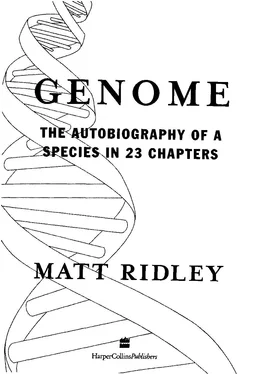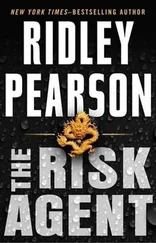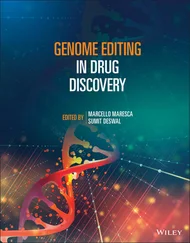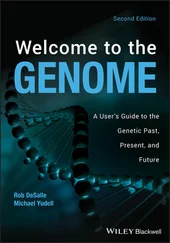Genome - Matt Ridley
Здесь есть возможность читать онлайн «Genome - Matt Ridley» — ознакомительный отрывок электронной книги совершенно бесплатно, а после прочтения отрывка купить полную версию. В некоторых случаях можно слушать аудио, скачать через торрент в формате fb2 и присутствует краткое содержание. Жанр: Старинная литература, на английском языке. Описание произведения, (предисловие) а так же отзывы посетителей доступны на портале библиотеки ЛибКат.
- Название:Matt Ridley
- Автор:
- Жанр:
- Год:неизвестен
- ISBN:нет данных
- Рейтинг книги:5 / 5. Голосов: 1
-
Избранное:Добавить в избранное
- Отзывы:
-
Ваша оценка:
- 100
- 1
- 2
- 3
- 4
- 5
Matt Ridley: краткое содержание, описание и аннотация
Предлагаем к чтению аннотацию, описание, краткое содержание или предисловие (зависит от того, что написал сам автор книги «Matt Ridley»). Если вы не нашли необходимую информацию о книге — напишите в комментариях, мы постараемся отыскать её.
Matt Ridley — читать онлайн ознакомительный отрывок
Ниже представлен текст книги, разбитый по страницам. Система сохранения места последней прочитанной страницы, позволяет с удобством читать онлайн бесплатно книгу «Matt Ridley», без необходимости каждый раз заново искать на чём Вы остановились. Поставьте закладку, и сможете в любой момент перейти на страницу, на которой закончили чтение.
Интервал:
Закладка:
So why do so many scientists persist in emphasising that asthma is at least partly a 'genetic disease'? What do they mean? Asthma is a constriction of the airways, which is triggered by histamines, which are in turn released by mast cells, whose transformation is triggered by their immunoglobulin-E proteins, whose activation is caused by the arrival of the very molecule to which they have been sensitised.
It is, as biological chains of cause and effect go, a fairly simple concatenation of events. The multiplicity of causes is effected by the design of immunoglobulin E, a protein specially designed to E N V I R O N M E N T 7 1
come in many forms, any one of which can fit on to almost any outside molecule or allergen. Although one person's asthma may be triggered by dust mites and another's by coffee beans, the underlying mechanism is still the same: the activation of the immunoglobulin-E
system.
Where there are simple chains of biochemical events, there are genes. Every protein in the chain is made by a gene, or, in the case of immunoglobulin E, two genes. Some people are born with, or develop, immunological hair-triggers, presumably because their genes are subtly different from those of other people, thanks to certain mutations.
That much is clear from the fact that asthma tends to run in families (a fact known, incidentally, to the twelfth-century Jewish sage of Cordoba, Maimonides). In some places, by accident of history, asthma mutations are unusually frequent. One such place is the isolated island of Tristan da Cunha, which must have been populated by descendants of an asthma-susceptible person. Despite a fine maritime climate, over twenty per cent of the inhabitants have overt symptoms of asthma. In 1997 a group of geneticists funded by a biotechnology company made the long sea voyage to the island and collected the blood of 270 of the 300 islanders to seek the mutations responsible.
Find those mutant genes and you have found the prime cause of the underlying mechnanism of asthma and with it all sorts of possibilities for a cure. Although hygiene or dust mites can explain why asthma is increasing on average, only differences in genes may explain why one person in a family gets asthma and another does not.
Except, of course, here for the first time we encounter the difficulty with words like 'normal' and 'mutant'. In the case of alkaptonuria it is pretty obvious that one version of the gene is normal and the other one is 'abnormal'. In the case of asthma, it is by no means so obvious. Back in the Stone Age, before feather pillows, an immune system that fired off at dust mites was no handicap, because dust mites were not a pressing problem in a temporary 7 2 G E N O M E
hunting camp on the savannah. And if that same immune system was especially good at killing gut worms, then the theoretical 'asthmatic'
was normal and natural; it was the others who were the abnormals and
'mutants' since they had genes that made them more vulnerable to worm infestations. Those with sensitive immunoglobulin-E systems were probably more resistant to worm infestations than those without. One of the dawning realisations of recent decades is just how hard it is to define what is 'normal' and what is mutant.
In the late 1980s, off went various groups of scientists in confident pursuit of the 'asthma gene'. By mid-1998 they had found not one, but fifteen. There were eight candidate genes on chromosome 5
alone, two each on chromosomes 6 and 12, and one on each of chromosomes 11, 13 and 14. This does not even count the fact that two parts of immunoglobulin E, the molecule at the centre of the process, are made by two genes on chromosome 1. The genetics of asthma could be underwritten by all of these genes in varying orders of importance or by any combination of them and others, too.
Each gene has its champion and feelings run high. William Cookson, an Oxford geneticist, has described how his rivals reacted to his discovery of a link between asthma-susceptibility and a marker on chromosome 11. Some were congratulatory. Others rushed into print contradicting him, usually with flawed or small sample sizes.
One wrote haughty editorials in medical journals mocking his 'logical disjunctions' and 'Oxfordshire genes'. One or two turned vitriolic in their public criticism and one anonymously accused him of fraud.
(To the outside world the sheer nastiness of scientific feuds often comes as something of a surprise; politics, by contrast, is a relatively polite affair.) Things were not improved by a sensational story exaggerating Cookson's discovery in a Sunday newspaper, followed by a television programme attacking the newspaper story and a com-plaint to the broadcasting regulator by the newspaper. 'After four years of constant scepticism and disbelief, says Cookson mildly,2
'we were all feeling very tired.'
This is the reality of gene hunting. There is a tendency among E N V I R O N M E N T 7 3
ivory-towered moral philosophers to disparage such scientists as gold-diggers seeking fame and fortune. The whole notion of 'genes for' such things as alcoholism and schizophrenia has been mocked, because such claims have often been later retracted. The retraction is taken not as evidence against that genetic link but as a condemnation of the whole practice of seeking genetic links. And the critics have a point. The simplistic headlines of the press can be very misleading. Yet anybody who gets evidence of a link between a disease and a gene has a duty to publish it. If it proves an illusion, little harm is done. Arguably, more damage has been done by false negatives (true genes that have been prematurely ruled out on inadequate data) than by false positives (suspicions of a link that later prove unfounded).
Cookson and his colleagues eventually got their gene and pinned down a mutation within it that the asthmatics in their sample had more often than others did. It was an asthma gene of sorts. But it only accounted for fifteen per cent of the explanation of asthma and it has proved remarkably hard to replicate the finding in other subjects, a maddening feature of asthma-gene hunting that has recurred with distressing frequency. By 1994 one of Cookson's rivals, David Marsh, was suggesting a strong link between asthma and the gene for interleukin 4, on chromosome 5, based on a study of eleven Amish families. That, too, proved hard to replicate. By 1997 a group of Finns was comprehensively ruling out a connection between asthma and the same gene. That same year a study of a mixed-race population in America concluded that eleven chromosomal regions could be linked to susceptibility to asthma, of which ten were unique to only one racial or ethnic group. In other words, the gene that most defined susceptiblity to asthma in blacks was not the same gene that most defined susceptibility to asthma in whites, which was different again from the gene that most defined susceptibility to asthma in Hispanics.3
Gender differences are just as pronounced as racial ones. According to research by the American Lung Association, whereas ozone from petrol-burning cars triggers asthma in men, particulates from 7 4 G E N O M E
diesel engines are more likely to trigger asthma in women. As a rule, males seem to have an early bout of allergy and to outgrow it, while females develop allergies in their mid or late twenties and do not outgrow them (though rules have exceptions, of course, including the rule that rules have exceptions). This could explain something peculiar about asthma inheritance: people often appear to inherit it from allergic mothers, but rarely from their fathers. This could just mean that the father's asthma was long ago in his youth and has been largely forgotten.
The trouble seems to be that there are so many ways of altering the sensitivity of the body to asthma triggers, all along the chain of reactions that leads to the symptoms, that all sorts of genes can be
Читать дальшеИнтервал:
Закладка:
Похожие книги на «Matt Ridley»
Представляем Вашему вниманию похожие книги на «Matt Ridley» списком для выбора. Мы отобрали схожую по названию и смыслу литературу в надежде предоставить читателям больше вариантов отыскать новые, интересные, ещё непрочитанные произведения.
Обсуждение, отзывы о книге «Matt Ridley» и просто собственные мнения читателей. Оставьте ваши комментарии, напишите, что Вы думаете о произведении, его смысле или главных героях. Укажите что конкретно понравилось, а что нет, и почему Вы так считаете.












